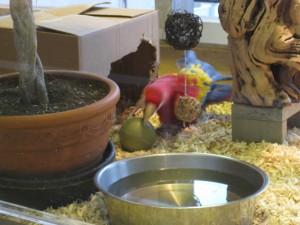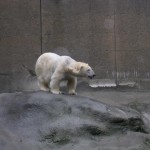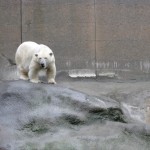Although continuous rain was forecast for the entire day, my niece decided that we could still enjoy ourselves if we got out of the house for a bit. She decided that the EcoTarium, Worcester’s unique indoor-outdoor science museum on Harrington Way, was the place to be. I had visited the museum many years ago and vaguely recalled how to get there, so late in the morning, armed with some scribbled directions from Mapquest, we set off.
We travelled the back roads through Spencer and Paxton, then turned onto Route 9 near Elm Park, drove east toward Downtown, missed the turn onto Plantation, circled around via Lake Avenue, and finally arrived. From the upper parking lot, we headed past the somewhat bedraggled owls and bald eagles toward the Main Entrance.
The EcoTarium houses a variety of animals, including this beautiful Scarlet Macaw (Ara macao). Native to Central and South America, this species eats mostly fruits, nuts, flowers, and nectar. In the photo, the bird is not eating but is playing with a toy. The Museum hopes to inspire in visitors “a passion for science and nature”; it began in 1825 as the Worcester Lyceum of Natural History, was incorporated in 1884 as the Worcester Natural History Society, and transitioned from the New England Science Center to the EcoTarium in 1998. The name change emphasized the organization’s transformation into an accessible learning and discovery center for families.
The Museum hopes to inspire in visitors “a passion for science and nature”; it began in 1825 as the Worcester Lyceum of Natural History, was incorporated in 1884 as the Worcester Natural History Society, and transitioned from the New England Science Center to the EcoTarium in 1998. The name change emphasized the organization’s transformation into an accessible learning and discovery center for families.
I think they do a pretty good job of science education, although I strongly believe that the animal exhibits should always include binomial nomenclature. For my part, I enjoyed the Minerals exhibit on the middle level and also some of the physics demonstrations. I had heard from friends that the Museum puts on some great shows in the Alden Planetarium, so my niece and I bought tickets to “Cosmic Collisions”:
Narrated by Robert Redford, this spectacular immersive theater experience launches guests on a thrilling trip through space and time to explore cosmic collisions. Groundbreaking scientific simulations and visualizations based on cutting-edge research depict the dramatic and explosive encounters that shaped our solar system.
By then, we were both hungry, so we headed back to the car for a picnic lunch. There were many more cars in the parking lot than we had expected; New Englanders are a hardy lot, I guess, or else parents feared their children going stir-crazy indoors.
After we had re-energized, we walked down the hill toward the polar bear (Ursus maritimus) exhibit. The only surviving daughter of Ursa Minor and Ursa Major, Kenda, a 26-year-old 600-pound female, is a star attraction. I took a couple of photos of her as she wandered about in her enclosure:
Kenda might look somewhat ragged, in that she is being treated for skin allergies; she is not particularly old for a bear in captivity, but in the wild, she probably would not have survived this long. Polar bears are now protected under the Endangered Species Act, due to decreasing ice cover in the Arctic where they live.
Now that we were outdoors and shielded by umbrellas, we decided to visit the otter habitat, but we did not see Ariel and Slydell. Had it been a sunny day, we might have waited to see if they would emerge from their den to play. Instead, we called it a day.

